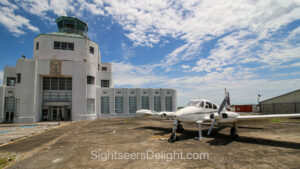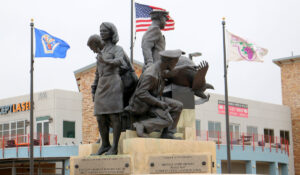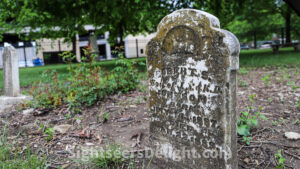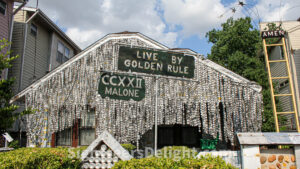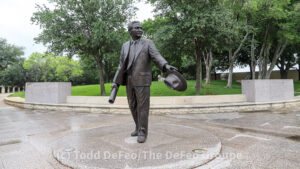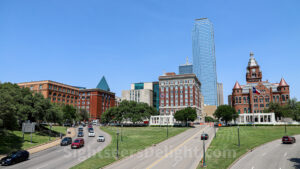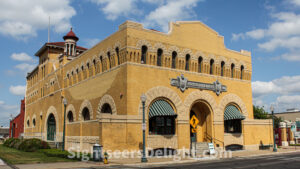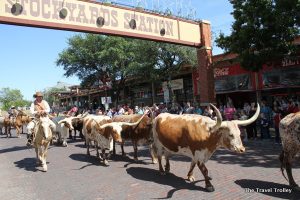The 1940 Air Terminal Museum is located at at William P. Hobby Airport and housed in the original art deco building which served as the first purpose-built terminal for passenger flight in Houston. The museum features collections focusing on civil aviation history in Space City. It is operated by the Houston Aeronautical Heritage Society (HAHS), a non-profit organization.
77061
The 9/11 Flight Crew Memorial was born out of American Airlines Flight Attendant Valerie Thompson’s desire to honor the crewmembers killed on the planes hijacked on Sept. 11: American Airlines flights 11 and 77 and United Airlines flights 93 and 175. Her dream became reality when the monument was dedicated on July 4, 2008. Based on a design by Bryce Cameron Liston of Salt Lake City, Utah, and sculpted by Dean Thompson, the memorial features bronze sculptures of two pilots, two flight attendants and a child who represents the traveling public. The memorial’s base stands 18 feet tall. The names of crewmembers on the four flights are engraved on slabs of granite surrounding the base.
76051
The Art Car Museum is a contemporary art museum that celebrates the post-modern age of car-culture. The museum features a collection of stock cars and lowriders that artists have remolded and customized to their choosing. The museum, nicknamed the Garage Mahal, opened in February 1988.
77007
Baccus Cemetery in Plano, Texas, dates to 1847 when Henry Cook established the cemetery to bury his son, Daniel. The cemetery was initially known as Cook Cemetery. After Cook died in 1862, his daughter, Rachel, acquired the land, and in 1878, she deeded it to Cook’s heirs for use as a cemetery and a church, Baccus Christian Church. While the church was later abandoned, the cemetery, named Baccus Cemetery in about 1915, is still in use.
75024
From the late 1960s until he died in the 1980s, John Milkovisch covered his house on Malone Street with crushed been cans. The house — today affectionately know as the Beer Can House — opened in 2008 as a folk art museum. For a small fee, visitors can tour the house and learn more about more about Milkovisch’s passion. From the late 1960s until he died in the 1980s, John Milkovisch covered his house on Malone Street with crushed been cans. The house — today affectionately know as the Beer Can House — opened in 2008 as a folk art museum. For a small fee, visitors can tour the house and learn more about more about Milkovisch’s passion. “They say every man should leave something to be remembered by. At least I accomplished that goal,” one Milkovisch quote painted on an interior wall reads.
77007
The 66-acre Dallas Arboretum and Botanical Gardens is located on the southeastern shore of White Rock Lake in East Dallas. Since opening to the public in 1984, the garden has received many accolades from publications including Architectural Digest, USA Today, Fodor’s Travel, Trip Advisor, The Travel Channel and many others. The Arboretum includes many formal and informal garden spaces, world-recognized trial gardens, a concert lawn, picnic areas, food service areas, a gift shop, orientation theater, classrooms and the historic DeGolyer House.
75218
Dealey Plaza is today synonymous with the 1963 assassination of President John F. Kennedy. However, the history of the plaza dates to 1935 when it was dedicated. Named for longtime Dallas Morning News publisher George Bannerman Dealey, the plaza was completed in 1940. Construction of the 15-acre plaza was made possible after the Trinity River was rerouted to prevent flooding in the area. Home to some of the first settlements, Dealey Plaza is sometimes known as the “birthplace of Dallas.”
75202
The Dr Pepper Museum in downtown Waco is dedicated to telling not just the story of Dr Pepper, but the story of the entire soft drink industry. Charles Alderton who developed a unique combination of flavors in 1885 in Dr. Wade Morrison’s Old Corner Drug Store. The soft drink — which, according to legend, Morrison named after the father of a girl he once loved — quickly became known as a “Waco.” The museum is located in the former Artesian Manufacturing and Bottling Company building. Completed in 1906, the structure was the first building built specifically to bottle Dr Pepper and remained in use until the 1960s when operations moved to a facility with more room for canning. The building remained vacant for roughly two decades until 1985 — the centennial of Dr Pepper — when work started to convert the building into a museum. The museum officially opened to the public on May 11, 1991.
76701
Fort Worth is often considered to be “where the West begins,” and the Fort Worth Stockyards was once the epicenter of the cattle industry. While still in active use for cattle sales, the historic stockyards attract thousands of tourists looking to climb atop a longhorn for a photo op, watch the twice-daily cattle drives or catch a glimpse of the unabated wild west. The Stockyards are home to a number of museums, including the Texas Cowboy Hall of Fame, the Texas Rodeo Cowboy Hall of Fame and the Stockyards Museum. And, of course, the Grapevine Vintage Railroad.
76164

